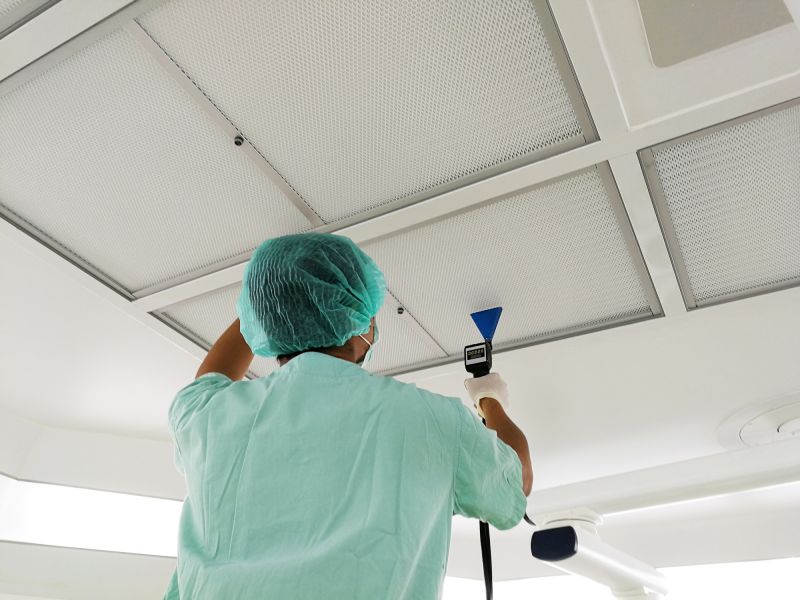Expert Picks For Iaq Testings Equipment You Can Trust
Find high-performance Iaq testing devices selected by professionals to help you detect pollutants and improve indoor air conditions.
 Indoor air quality (IAQ) testing is an essential process for assessing the safety and comfort of indoor environments. Various products are available to help individuals and professionals measure pollutants, allergens, humidity levels, and other air quality indicators. These tools range from simple handheld devices to more advanced testing kits, providing valuable data to identify potential issues such as mold, volatile organic compounds (VOCs), particulate matter, and humidity imbalances. Proper testing can aid in determining whether indoor air conditions meet health standards or if further remediation is necessary.
Indoor air quality (IAQ) testing is an essential process for assessing the safety and comfort of indoor environments. Various products are available to help individuals and professionals measure pollutants, allergens, humidity levels, and other air quality indicators. These tools range from simple handheld devices to more advanced testing kits, providing valuable data to identify potential issues such as mold, volatile organic compounds (VOCs), particulate matter, and humidity imbalances. Proper testing can aid in determining whether indoor air conditions meet health standards or if further remediation is necessary.
Top Overall Option
Multi-Parameter Indoor Air Quality Monitor
A versatile and comprehensive device capable of measuring multiple air quality parameters including particulate matter, VOCs, humidity, and temperature. Its user-friendly interface and real-time data display make it suitable for both casual users and professionals seeking detailed insights into indoor air conditions.
Types of Products For Iaq Testings
Handheld Particulate Matter Meters
Portable devices designed to measure levels of airborne particles, ideal for quick spot checks in various environments.
VOC Detectors
Devices that identify and quantify volatile organic compounds present in indoor air, useful for detecting off-gassing from materials or products.
Humidity and Temperature Sensors
Tools that monitor moisture levels and temperature, helping to identify conditions conducive to mold growth or discomfort.
Indoor Air Quality Test Kits
Comprehensive kits that include multiple testing tools and reagents for detailed analysis of various indoor pollutants.
Mold Test Swabs
Specialized swabs used to collect samples from surfaces for laboratory analysis of mold presence.
Carbon Dioxide Monitors
Devices that measure CO2 levels to assess ventilation efficiency and indoor air freshness.
Particulate Counters
Advanced instruments that count and size airborne particles, providing detailed particulate profiles.
Radon Detectors
Tools designed to detect radon gas levels, which can be a concern in certain indoor environments.
Air Quality Data Loggers
Devices that record air quality parameters over time for trend analysis and comprehensive monitoring.
Laser Particle Counters
High-precision instruments that use laser technology to measure airborne particles with accuracy.
Popular Choices
Compact devices favored for their ease of use and quick readings of airborne particles in various settings.
Widely used for their ability to provide immediate insights into indoor chemical pollutants.
Popular for assessing ventilation and air freshness in homes and workplaces.
Commonly used to prevent mold growth and maintain comfort by monitoring moisture levels.
Frequently chosen for their convenience in detecting mold spores on surfaces and in the air.
Popular for home safety assessments related to radon exposure risks.
Preferred for long-term monitoring and trend analysis in various indoor environments.
Chosen for their high accuracy in detailed airborne particle measurement.
Popular for providing comprehensive data on multiple air quality factors simultaneously.
Choosing the right IAQ testing products involves understanding the specific needs of the environment, whether it is a residential home, office, or industrial space. Some devices are designed for quick, on-the-spot readings, while others offer comprehensive analysis and data logging capabilities. For those concerned about health and safety, selecting accurate and reliable testing tools is crucial. It is also important to consider ease of use, maintenance requirements, and the ability to interpret results effectively.
Many IAQ testing products are portable and user-friendly, making them suitable for DIY inspections or professional assessments. Some kits include multiple sensors to evaluate different aspects of air quality simultaneously, providing a more complete picture of indoor conditions. Regular testing can help detect issues early, allowing for timely interventions that improve overall air quality and occupant well-being. Whether for routine monitoring or specific problem-solving, having the right testing equipment is a valuable part of maintaining a healthy indoor environment.
Key Buying Considerations
- Determine the specific air quality parameters you need to measure, such as particulate matter, VOCs, humidity, or radon.
- Consider the accuracy and sensitivity of the device to ensure reliable readings.
- Evaluate whether the device provides real-time data or requires laboratory analysis.
- Assess ease of use, including display clarity, interface simplicity, and setup process.
- Check for portability if you plan to perform on-the-go testing in multiple locations.
- Review battery life and power options for continuous or extended use.
- Look into data logging capabilities if long-term monitoring or trend analysis is desired.
- Ensure the device is suitable for the environment you are testing, whether residential, commercial, or industrial.
- Consider maintenance requirements, calibration needs, and availability of replacement parts or reagents.
- Read user reviews and ratings to gauge reliability and user satisfaction.
- Verify if the device complies with relevant safety and quality standards.
- Assess the size and weight for ease of handling and storage.
- Determine if additional accessories, such as calibration kits or surface swabs, are necessary.
- Think about the level of technical support or customer service provided by the manufacturer.
- Evaluate the overall cost and whether it fits within your budget for ongoing testing needs.
This page contains affiliate links and may earn a commission for purchases made through these links, at no additional cost to you.
